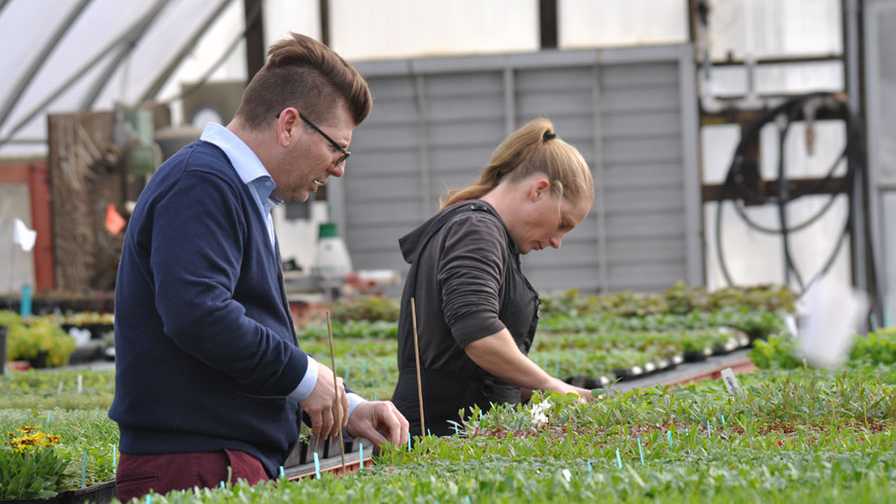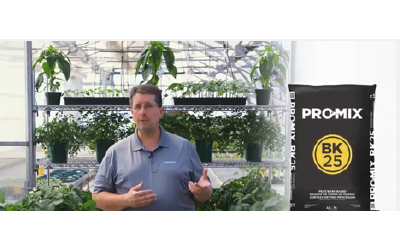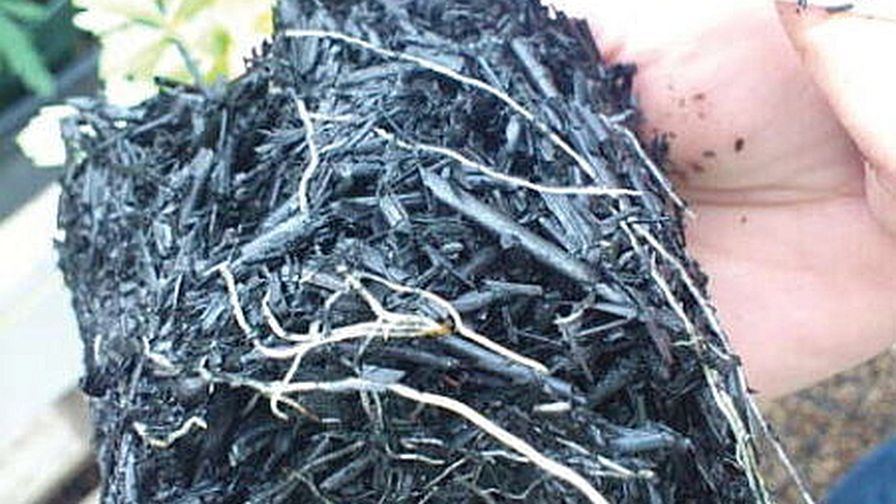Tips to Whip Thrips in the Greenhouse

Thrips feeding damage on calibrachoa.
Photo courtesy of Griffin Greenhouse
Entomopathogenic nematodes cause the death of certain insects by releasing a bacterium that’s harmless to the nematode but deadly to the insect. Steinernema feltiae is an example of such a nematode that’s been used with good success against fungus gnat larvae for many years. More recently, this nematode has been used to combat Western flower thrips with varying degrees of success.
Planning the Perfect Ambush
Anecdotally, some growers have reported success with foliar applications of nematodes to control thrips. This has left entomologists scratching their heads, since research indicates mortality rates from this type of application are generally low.i S. feltiae is as much an ambush nematode, lying in wait to pounce on its prey, as it is a forager. Chasing down fast-moving thrips in a puddle of water on the foliage of plants would seem to be a tall order for the nematodes. Add to that the fact they’re very susceptible to ultraviolet light, and the odds seem against such treatments being successful.
The pre-pupal and pupal stages of thrips are sessile, meaning they don’t move. Research indicates that most of the pupation takes place on the surface of the soil, even when flowers are present, although it varies somewhat by plant species.ii Soil is the natural habitat of the nematodes, so their longevity is much better here versus foliar treatments where they survive, at the most, for a few hours. That combination would seem to favor soil applications for thrips control.
It’s possible, however, that growers who’ve been successful with foliar sprays of nematodes were applying them with sufficient water volume that nematodes were reaching the soil surface to assist with control. Soil treatments also allow for control of fungus gnat larvae, which is an important bonus.
Tips for Success
Applying living organisms, such as beneficial nematodes, carries extra considerations when compared to a typical chemical treatment. In preparation for the application, make sure to remove injector and sprayer screens that are 50 mesh or smaller. That will ensure the nematodes pass through the irrigation system unimpeded.
If a sprayer will be used in the application, keep the pressure below 200 pounds per square inch (psi) if possible, with 300 psi being the maximum. After spraying, follow up immediately with enough water to rinse the nematodes down to the soil surface.
Refrigerator storage temperatures are 38°F to 40°F, so allow the nematode packages to come up to room temperature before mixing with water. Ideal water temperatures for mixing and applying are 60°F to 75°F (16°C to 26°C), quite a shock if the nematodes aren’t given a chance to acclimate.
During warmer times of the year, the stock bucket can actually get too warm, which may decrease nematode viability. In that case, insert a cold pack into the stock bucket to ensure the water temperature stays within the ideal range.
Nematodes are heavier than water, so without gentle circulation, they’ll quickly settle to the bottom of the stock tank or sprayer, leading to uneven distribution. Ideally, the nematode application should begin as soon as they’re uniformly mixed into the stock bucket.
Oxygen begins to be depleted in the stock tank and can reach critical levels after about an hour. Gentle bubbling of air through the stock tank can be used to keep the water oxygenated as well as provide the gentle mixing required to keep the nematodes in a uniform distribution throughout the tank. Dramm has an agitation/aeration bucket designed specifically for this use. Inventive growers have also come up with remedies of their own. Either way, it’s important not to supply so much air that vigorous bubbling results in damage to the nematodes.
The recommended nematode application rate to combat thrips pupae and fungus gnat larvae is 50 million per 1,100 square feet. Applying 30 to 50 gallons per 1,000 square feet is a good drench volume. Reapplications are generally made at three-week intervals, depending on pest pressure.
BASF offers a compatibility guide showing which pesticides and adjuvants can be safely tank-mixed with nematodes. While GGSPro does not recommend tank-mixing nematodes with pesticides, the table is useful for knowing which pesticides can be applied over the top of the nematodes without harming them.
S. feltiae can be an important part of Western flower thrips control whether you employ a biological or a traditional chemical program. Consult with your supplier to discuss options to control other life stages of thrips by either method.
References
iBuitenhuis R, Shipp JL, 2005. Efficacy of entomopathogenic nematode Steinernema feltiae (Rhabditida: Steinernematidae) as influenced by Frankliniella occidentalis (Thysanoptera: Thripidae) developmental stage and host plant stage, J Econ Entomol. Oct;98(5):1480-5.
iiBuitenhuis, R. and J.L. Shipp, 2008. Influence of plant species and plant growth stage on Frankliniella occidentalis pupation behavior in greenhouse ornamentals. Journal of Applied Entomology 132: 86-88










